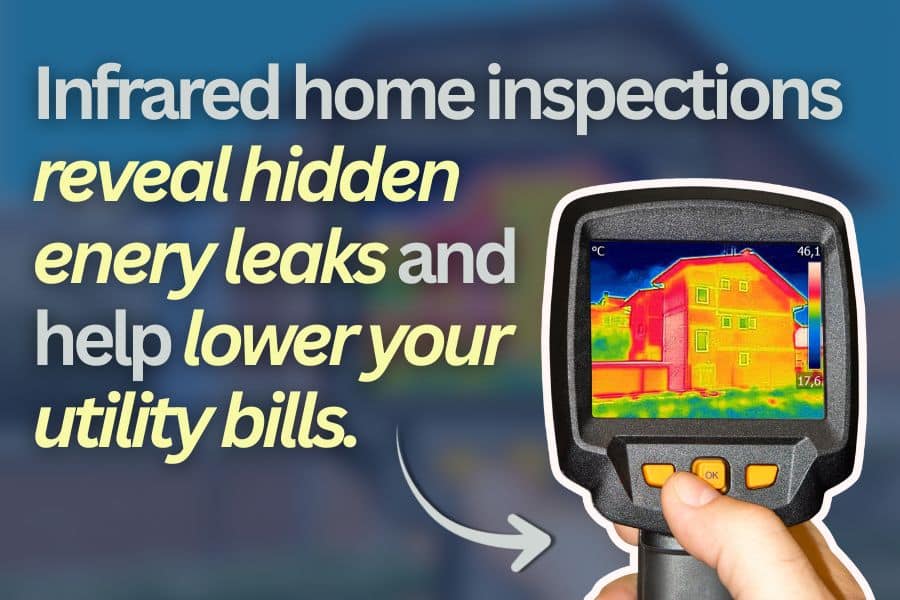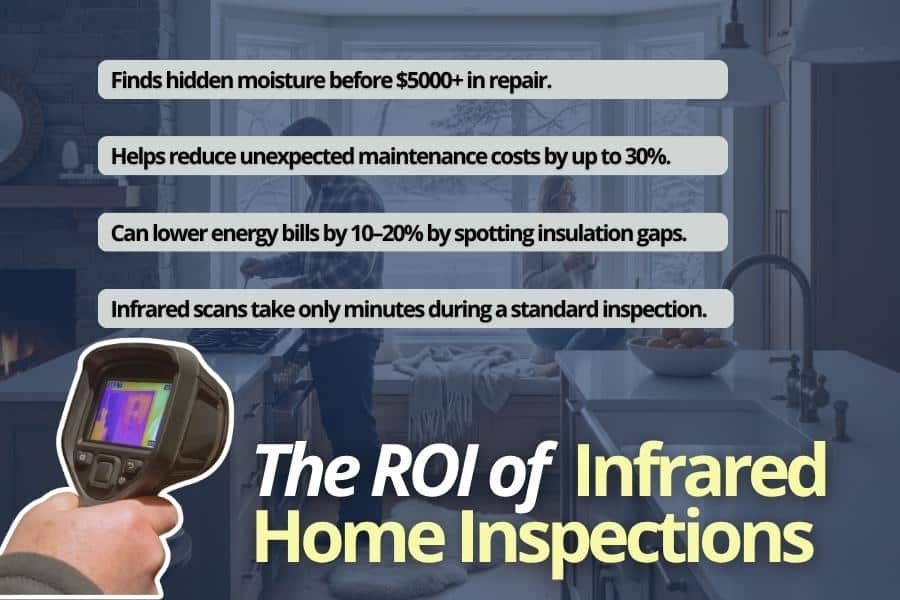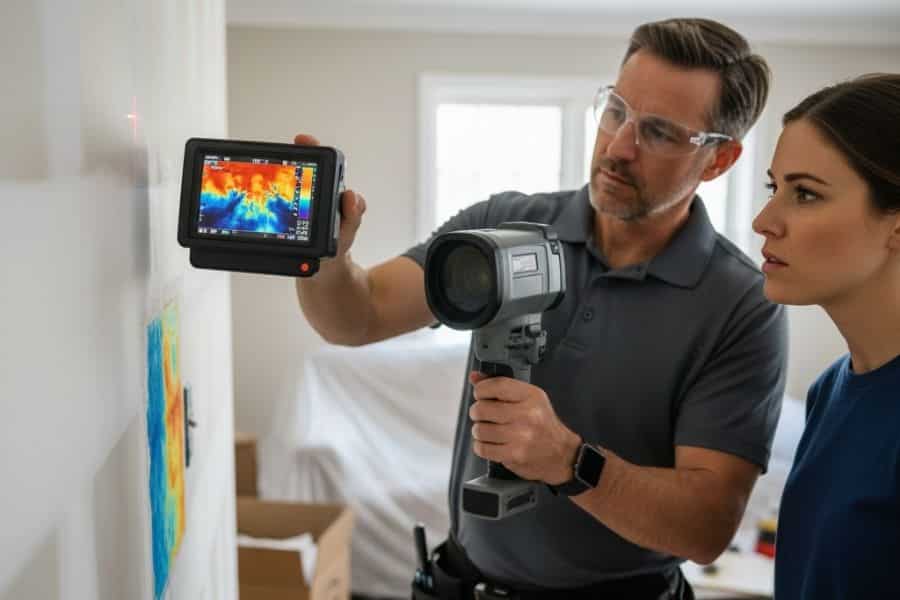An infrared camera home inspection helps find hidden problems that are hard or impossible to see with your eyes alone. Thermal imaging picks up temperature changes inside walls, ceilings, and floors. These temperature changes help a home inspector spot moisture, hot electrical parts, air leaks, missing insulation, and more. For homeowners and homebuyers, infrared gives you a clearer picture of what is really happening inside a house.
Below is a simple guide that explains what infrared can reveal, how it works, and why it is helpful when buying or maintaining a home.

What an Infrared Camera Home Inspection Can Reveal
Thermal imaging works by showing the surface temperature of materials inside the home. When something is warmer or cooler than the area around it, the infrared camera picks it up as a brighter or darker color. Those patterns help the inspector figure out if something might be wrong.
A trained inspector uses infrared to look at walls, ceilings, floors, electrical panels, plumbing areas, and parts of the home’s exterior. Many problems stay hidden until they grow into bigger issues. Infrared helps find clues earlier so repairs can be made before major damage starts.
Home inspectors often use infrared along with a regular visual inspection. This is because infrared shows temperature differences but does not explain the cause by itself. When used together, the inspector can give a much clearer picture of what is happening inside the home.
Below is a practical comparison of common home problems and how thermal imaging can help identify each one.
| Problem Type | Can You See It With Your Eyes? | Can Infrared Detect It? | Why Infrared Helps |
|---|---|---|---|
| Moisture in walls or ceilings | Often no | Yes | Moisture shows cooler areas on the camera before staining appears |
| Active plumbing leaks | Sometimes | Yes | Infrared highlights temperature changes from water movement |
| Roof leaks | Rarely | Yes | Wet spots under roofing materials show distinct patterns |
| Electrical hot spots | No | Yes | Hot breakers, loose connections, and overheating parts appear warmer |
| Missing or thin insulation | No | Yes | Insulation gaps show as hot or cold patches |
| Air leaks around windows, doors, and outlets | Sometimes | Yes | Cold or warm air appears as streaks on infrared images |
| HVAC airflow problems | Sometimes | Yes | Thermal imaging shows uneven temperatures at vents |
| Hidden structural moisture | No | Yes | Temperature differences reveal wet framing or materials |
| Past repairs vs. active issues | Hard to tell | Yes, with moisture meter | Pairing infrared and moisture tools helps confirm active leaks |
Hidden Moisture Problems Infrared Cameras Can Find
Moisture is one of the biggest issues homeowners face. Water leaks may begin very small and may not show staining or damage right away. However, moisture absorbs heat, so wet spots show up cooler than dry areas in thermal images. This makes them easier to find.
Infrared cameras help spot:
- Roof leaks
- Plumbing leaks
- Shower or tub leaks
- Water near windows or doors
- Moisture inside walls during rainy weather
- Damp spots in ceilings after storms
Some leaks may be old. Others may still be active. With thermal imaging and a moisture meter, an inspector can often tell the difference. This helps homeowners understand if a past repair worked or if a current leak still needs attention. Early moisture detection protects you from mold, damaged drywall, wood rot, and higher repair bills.
How Infrared Detects Electrical Hot Spots
Electrical problems are another hidden danger in a home. Many electrical issues create heat long before they fail. Thermal imaging can show temperature changes in outlets, breakers, wiring, and panels.
Some common problems include:
- Loose electrical connections
- Overloaded circuits
- Failing breakers
- Damaged wiring
- Overheated light fixtures
These areas often look bright or warm in infrared images. They may signal a safety concern that needs repair. Not every warm spot means danger though. Some electrical parts simply run warm when operating normally. A trained inspector understands the difference and can explain what needs attention and what does not.
Finding Insulation Gaps and Energy Loss
Infrared cameras are excellent at spotting areas where the home is losing energy. Missing insulation, damaged insulation, or gaps around openings cause hot or cold air to move in or out of the home. This raises energy bills and makes rooms feel uneven in temperature.
IR imaging helps find:
- Missing or thin insulation in walls or ceilings
- Drafts around windows and doors
- Cold air leaking around outlets on exterior walls
- Heat escaping through attic access panels
- Insulation issues behind knee walls or sloped ceilings
When an inspector shows these patterns to a homeowner, it becomes much easier to understand where comfort problems are coming from. Fixing these issues can lower energy costs and make the home more comfortable year-round.
Infrared for Structural and HVAC Clues
Structural problems often start with moisture, settling, or changes in materials. Infrared does not see through walls, but it does show temperature patterns on their surfaces. A sharp temperature change in a straight line might show wet framing, uneven insulation, or air moving where it should not be.
It can also help highlight:
- Areas of past water damage
- Sections of walls that have shifted or buckled
- Hidden moisture near exterior siding or stucco
- Temperature differences caused by damaged building materials
Because infrared is so sensitive, inspectors must interpret images carefully. Not every pattern is a problem. Sometimes it is just sunlight warming part of a wall. A trained inspector knows how to compare patterns and confirm concerns with other tools.
Using Infrared to Check HVAC Performance
Heating and cooling issues are common in many homes. If the system is not delivering air correctly, or if ducts are leaking, infrared can reveal the problem.
Infrared can show:
- Weak airflow at vents
- Duct leaks inside walls or attics
- Rooms that heat or cool unevenly
- Cold or warm spots around HVAC units
- Temperature differences across returns or registers
Sometimes the clues are simple, such as cold air leaking around a vent or warm air escaping near a duct joint. These small problems may lead to higher bills or uneven comfort.
Why Adding Infrared Helps Homeowners Make Better Decisions
An infrared camera home inspection gives homeowners clearer information than a visual inspection alone. It helps you feel confident that hidden problems have been checked. Thermal imaging is safe, noninvasive, and fast. Most scans take only minutes during a standard home inspection.
Here is why homeowners find infrared helpful:
- It reveals hidden moisture early before damage spreads
- It helps verify past repairs
- It supports better negotiation during a home purchase
- It identifies energy loss that raises utility bills
- It adds clarity when something feels off but there are no visible signs

An inspector walks you through the images and explains what each pattern means. This helps you understand the condition of the home and what repairs or maintenance may be needed.
When you know what is going on behind the walls, you can make smart decisions and avoid surprises after moving in.
Related Questions
Is an infrared camera home inspection worth it?
Yes. It can help find moisture, air leaks, electrical concerns, and insulation gaps that are not visible. This helps prevent costly repairs.
Do all home inspectors use thermal imaging?
No. Some inspectors include it at no cost, while others offer it as an add-on service. Always ask if infrared is included.
Can infrared find mold?
Infrared does not see mold directly. It finds moisture that may lead to mold growth. A moisture meter helps confirm what the camera sees.
Will infrared show leaks behind walls?
It can show temperature changes caused by leaks. A moisture meter helps confirm active moisture.
Can infrared detect electrical issues?
Yes, but only temperature differences. A warm area may be normal, so a trained inspector must interpret the image correctly.
How long does an infrared inspection take?
It is usually completed within the time of a standard home inspection because the camera works quickly.
Conclusion
An infrared camera home inspection gives you a clearer look at what is happening inside your home. It helps find hidden leaks, hot electrical parts, air leaks, and insulation gaps long before they turn into expensive repairs. When paired with a standard home inspection, thermal imaging gives homeowners and buyers the confidence they need to make smart decisions.
If you want a deeper look at your home and peace of mind about hidden issues, you can schedule an inspection with P.I. Inspections today. Our certified inspectors use advanced infrared technology to catch problems early, saving you thousands in future repairs. Let us help you protect your investment with a thorough, professional inspection.

